一、什么是特性路由?
特性路由是指将RouteAttribute或自定义继承自RouteAttribute的特性类标记在控制器或ACTION上,同时指定路由Url字符串,从而实现路由映射,相比之前的通过Routes.Add或Routes.MapHttpRoute来讲,更加灵活与直观。
若要使用特性路由功能需要先在Application_Start中开启映射到特性路由,代码如下:
1 2 3 | GlobalConfiguration.Configuration.MapHttpAttributeRoutes();
config.MapHttpAttributeRoutes();
|
二、特性路由使用方法
1.基本路由映射
1 2 3 4 5 | [Route("api/Values")]
public IEnumerable<string> Get()
{
return new string[] { "value1", "value2" };
}
|
访问地址:http://localhost:34732/api/values,结果如下:

2.路由映射到参数
1 2 3 4 5 | [Route("api/Values/{id}")]
public string Get2(int id)
{
return "value:" + id.ToString();
}
|
访问地址:http://localhost:34732/api/values,结果如下:

3.多重特性路由
1 2 3 4 5 6 | [Route("api/Values/{value1}/{value2}")]
[Route("api/Demo/{value2}/{value1}")]
public IEnumerable<string> Get3(string value1, string value2)
{
return new[] { value1, value2 };
}
|
访问地址:http://localhost:34732/api/values/a/b 或 http://localhost:34732/api/demo/a/b,结果如下:

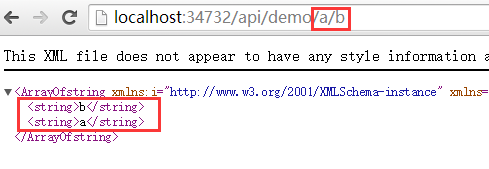
4.缺省(默认)参数路由
1 2 3 4 5 6 7 8 9 10 11 12 13 14 15 16 17 |
[Route("api/Values/option/{key}/{value?}")]
public Dictionary<string, string> Get4(string key, string value = "test")
{
return new Dictionary<string, string>() {
{key,value}
};
}
[Route("api/Values/option/{key}/{value=test}")]
public Dictionary<string, string> Get5(string key, string value)
{
return new Dictionary<string, string>() {
{key,value}
};
}
|
访问地址:http://localhost:34732/api/Values/option/a, http://localhost:34732/api/Values/option/a/api 结果如下:
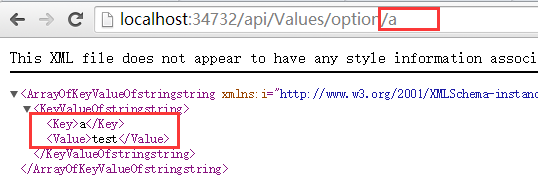
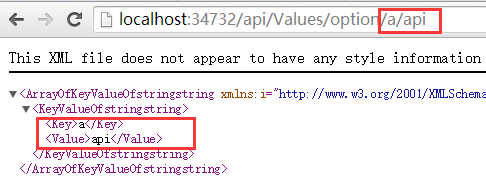
5.参数约束路由
1 2 3 4 5 | [Route("api/Values/constraint/{id:range(1,10)}")]
public string Get6(int id)
{
return "value:" + id.ToString();
}
|
访问地址:http://localhost:34732/api/Values/constraint/10, http://localhost:34732/api/Values/constraint/11 结果如下:

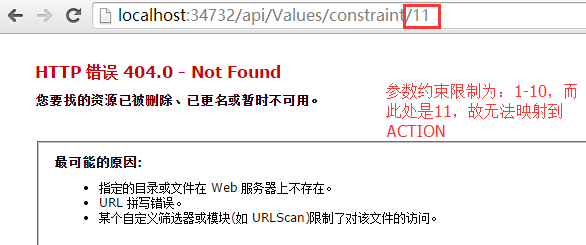
系统已提供的参数约束使用方法如下表(图片来源于蒋金楠书中):

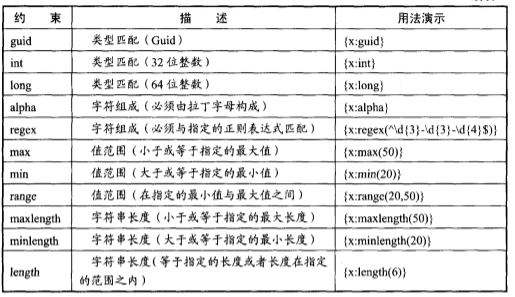
6.通配符(*)路由变量
1 2 3 4 5 | [Route("api/Values/many/{isOk:bool}/{*getDate:datetime}")]
public IHttpActionResult Get7(bool isOk, DateTime? getDate = null)
{
return Json(new { Ok = isOk, Date = getDate });
}
|
访问地址:http://localhost:34732/api/Values/many/true/2016-3-13, http://localhost:34732/api/Values/many/false/2016/3/13 结果如下:


7.路由映射(绑定)到复杂参数
1 2 3 4 5 6 7 8 9 10 11 12 13 14 15 16 17 18 19 20 21 | [ModelBinder]
public class Point
{
public int x { get; set; }
public int y { get; set; }
}
[Route("api/Values/model/{a.x:int}/{a.y:int}/{b.x:int}/{b.y:int}")]
public IEnumerable<Point> Get8(Point a, Point b)
{
return new[] { a, b };
}
[Route("api/Values/model")]
public IEnumerable<Point> Get9(Point a, Point b)
{
return new[] { a, b };
}
|
访问地址:http://localhost:34732/api/Values/model/1/2/3/4, http://localhost:34732/api/Values/model?a.x=10&a.y=20&b.x=30&b.y=40 结果如下:


8.统一定义路由前缀及取消路由前缀
1 2 3 4 5 6 7 8 9 10 11 12 13 14 15 16 | [RoutePrefix("api/demo")]
public class DemoController : ApiController
{
[Route("Values")]
public IEnumerable<string> Get()
{
return new string[] { "value1", "value2" };
}
[Route("~/api/Values/{id}")]
public string Get(int id)
{
return "value:" + id.ToString();
}
|
访问地址:http://localhost:34732/api/demo/values, http://localhost:34732/api/values/1 结果如下:


上面曾讲到过参数约束,其实除了系统提供的约束,还可以自定义实现IHttpRouteConstraint的约束类,下面是一个中英文切换的语言约束示例,代码实现如下:
首先定义一个中英文语言约束类:
1 2 3 4 5 6 7 8 9 10 11 12 13 14 15 16 17 | public class CultureRouteConstraint : IHttpRouteConstraint
{
private static List<string> allowCultureList;
static CultureRouteConstraint()
{
allowCultureList = new List<string> { "zh-cn","en-us"};
}
public bool Match(System.Net.Http.HttpRequestMessage request, IHttpRoute route, string parameterName, IDictionary<string, object> values, HttpRouteDirection routeDirection)
{
if (values.ContainsKey(parameterName))
{
return allowCultureList.Any(c => c.Equals(values[parameterName].ToString(), StringComparison.OrdinalIgnoreCase));
}
return false;
}
}
|
然后将其添加到默认路由约束解析器(DefaultInlineConstraintResolver)的参数与约束映射字典中,代码如下:
1 2 3 4 5 | DefaultInlineConstraintResolver defaultInlineConstraintResolver = new DefaultInlineConstraintResolver();
defaultInlineConstraintResolver.ConstraintMap.Add("culture", typeof(CultureRouteConstraint));
config.MapHttpAttributeRoutes(defaultInlineConstraintResolver);
|
最后就可以像使用普通约束一样来使用该约束,在使用约束前,定义两个资源文件,分别为:默认资源文件(中文):Resources.resx,英文资源文件:Resources.en-us.resx
两个资源文件内容如下:


WEB API 的ACTION定义如下:
1 2 3 4 5 6 7 8 9 10 11 12 13 14 15 16 17 18 | [Route("api/Values/constraint/{culture:culture}/{name}")]
public string Get10(string culture,string name)
{
CultureInfo currentCultureInfo = CultureInfo.CurrentCulture;
CultureInfo currentCultureUIInfo = CultureInfo.CurrentUICulture;
try
{
Thread.CurrentThread.CurrentCulture = Thread.CurrentThread.CurrentUICulture =
new CultureInfo(culture);
return Resources.ResourceManager.GetString(name.ToString());
}
finally
{
Thread.CurrentThread.CurrentCulture = currentCultureInfo;
Thread.CurrentThread.CurrentUICulture = currentCultureUIInfo;
}
}
|
访问地址:http://localhost:34732/api/Values/constraint/zh-cn/hello, http://localhost:34732/api/Values/constraint/en-us/hello 结果如下:


如果访问其它的语言,比如:http://localhost:34732/api/Values/constraint/zh-tw/hello,就会因约束限制而无法映射到ACTION,从而提示找不到页面,如下:
